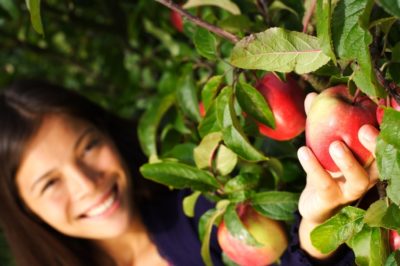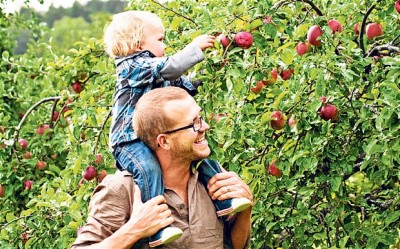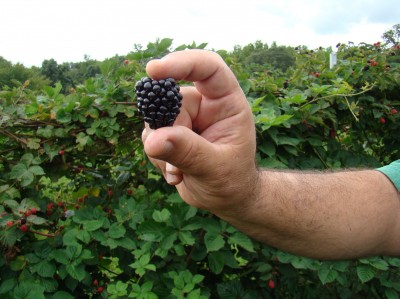 When I was young, my grandmother had a copse of raspberry bushes. The fruit would grow so fat that the drupelets would bleed onto our fingers as we picked them. Grandma made lovely jams and syrups with the berries that made it into the basket instead of our mouths. Unfortunately, my talent for growing things stops at fruit bushes and trees.
When I was young, my grandmother had a copse of raspberry bushes. The fruit would grow so fat that the drupelets would bleed onto our fingers as we picked them. Grandma made lovely jams and syrups with the berries that made it into the basket instead of our mouths. Unfortunately, my talent for growing things stops at fruit bushes and trees.
In order to bring home grown fruit to the table, I’ve learned to scrounge and barter for it. There is a certain way to go about this without alienating the sources. I’ve found that people who have too much fruit are generous to a point. Never appear greedy by taking more than the owner expected, and always offer something in return, whether it’s a straight trade, or a surprise gift after you’ve been allowed to harvest.
Let’s review a few resources. A few recipes are included for fun.
Your Neighbors’ Yards
My next door neighbor has a giant crab apple tree, but he lets the fruit go to rot on the ground, or mows them over. I offered to clean them up if I was allowed to take them, and he agreed.
Even though it’s a win-win situation (I get crab apples and he gets his yard cleaned), I am still careful to avoid offending him. I don’t pick up only the good crab apples; I pick up all of them, and dispose of the bad ones in my compost pile. I also surprise him here and there with fresh tomatoes or cucumbers. You can never be too gracious to your sources.
New “Survival Herb Bank” Gives You Access to God’s Amazing Medicine Chest
The bad news about crab apples is it’s easy to get a bellyache from eating them raw. If I want to eat crab apples by themselves, I slice off both ends, then roast them in an oven or over a fire. Heating them alters them enough that they can be digested without problems.
Because they come of age in the cool of early fall, crab apples are great for making hot cider. Slice off both ends with a paring knife, then slice off as much skin as you are able before deciding you don’t really want cider after all. Place the mostly skinned apples into a stock pot, and cover with water.

Image source: Telegraph
Boil the apples until they are soft, but not long enough to turn them into sauce. Drain the fruit through a fine-meshed sieve or cheesecloth, catching the cider into a second stockpot. Add sugar to taste. Heat and stir the cider until the sugar is completely dissolved, then immediately transfer into a storage container. I like to add cinnamon sticks to the container.
The remaining apples can be minced or blended, and baked into breads. I use them to replace one of three bananas in my banana bread recipe.
Ingredients:
- 1 1/2 cups peeled, boiled crab apples
- 2 bananas
- 2 cups flour
- 3/4 cup brown sugar
- 1 teaspoon baking soda
- 4 pinches salt
- 1/2 cup butter
- 2 eggs
- 1 capful vanilla
In a bowl, combine flour, baking soda and salt. In another bowl, combine cream butter, brown sugar and vanilla with a mixer. Add crab apples, bananas, and eggs, and mix on low until well-blended. Stir in flour mixture with a wooden spoon until ingredients are incorporated. Pour into a greased loaf pan, and bake at 350 degrees Fahrenheit for about an hour, or until a knife inserted into the center comes out clean.
Alternatively, boil the apples into sauce. When they begin to break down, stir them constantly to avoid burning them into the bottom of the pan. Sweeten the sauce with maple syrup and honey.
Wild Berry Bushes And Trees

Image source: PatchworkTimes.com
In most places, wild berry bushes and trees that grow along roadsides, or along wooded areas, are not truly wild, because somebody owns them. If it’s a landowner, you’re going to need to be especially friendly. Whether I know the landowner or not, I always offer a trade or cash up front. If the property is owned by the government, it’s controlled by either a state or county department. Many states allow harvesting with a permit; in other states, the game warden may grant you unofficial permission.
Keep in mind that most “wild” areas are usually managed with chemicals. Ask whomever is in control about when the plants have been sprayed, and find out the brand and product name of the chemical used. A quick Internet search on the product name and the term “harvest interval” will reveal how many days you should wait between the date the plants were chemically treated and the date the fruit can be picked.
I prefer to avoid bushes and trees that are managed with chemicals, but if you ask around, you can usually find specimens that aren’t. In my area, I most often score mulberries.
Mulberries are a bit tricky to preserve. Alone, they are good for freezing, or making wine or syrup. As a jam, they should be added to another fruit, like strawberry, in order to set properly. Use the amount of pectin recommended for blueberries or raspberries.
A recipe that is good the same day mulberries are picked is fruit crisp.
Ingredients:
- 4 cups berries
- 2 tablespoons lemon juice
- 3/4 cup sugar
- 3/4 cup brown sugar
- 6 teaspoons melted butter
- 2 tablespoons flour
- 1 teaspoon cinnamon
Preheat oven to 350 degrees Fahrenheit. Combine fruit, lemon juice, and sugar in a small baking dish. In a large mug, combine brown sugar, flour, butter and cinnamon. Sprinkle over the fruit mixture. Bake for 40 to 50 minutes, until the top is crisp.
You can also bake these in ramekins for a fancier presentation. Mulberry crisp is great served with clotted cream.
Do you have other tips for getting free or low-cost fruit? Let us know in the comments section below.
Sign up for Off The Grid News’ weekly email and stay informed about the issues important to you
 Off The Grid News Better Ideas For Off The Grid Living
Off The Grid News Better Ideas For Off The Grid Living




